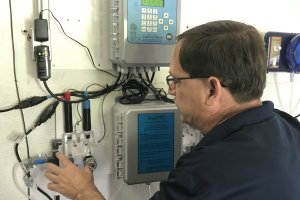Understanding ORP and PPM

Tuesday, January 23, 2018
Despite the fact that swimming pool ORP/pH controllers are commonplace on commercial swimming pools, users do not often fully understand how ORP works.
Oxidation-Reduction Potential is a qualitative measurement that constantly changes, especially outdoors. This is primarily due to variations in cyanuric acid (CYA) levels and sunlight intensity, but also from pH, combined chlorine and salt-chlorine generators. As these factors fluctuate, ORP measurements changes throughout the day.
Because ORP is a moving target, it is best for professionals to watch it in combination with chlorine residual in parts per million (ppm). This helps gain a complete picture, ensure high water quality and comply with local heath department regulations. Pools can be run very efficiently with ORP controllers, if they are properly understood. To help operators, controller manufacturers have ventured into utilizing sensors that measure chlorine ppm in addition to ORP. Understanding the basis of each measurement can help operators manage their pools.
ORP
ORP is probably the most common method used by chemical controllers to measure sanitizer level, and the most inexpensive type of system. But pool operators, especially novices, often misunderstand ORP as an actual measurement of sanitizer.
Oxidation-Reduction Potential measures the oxidizing properties of any sanitizer present in the water. When chlorine is free to oxidize, sensors generate a millivolt reading, expressed as ORP. If the chlorine isn’t free and available, a millivolt reading will not be generated.
It is important to remember that the “P” in ORP stands for potential. ORP measures the water’s ability to oxidize and is therefore dependent on pH when the primary sanitizer is chlorine. CYA levels can affect the readings taken by an ORP sensor, as can salt systems. (Often, on salt chlorine installations, special metals must be used for the electrodes to prevent build-up on the sensor, making proper installation and care of the sensors especially important. )
The ORP sensor doesn’t measure anything specific. It will not differentiate between chlorine, ozone, bromine or potassium monopersulfate (MPS).
Even sunlight affects ORP readings. That’s why pool operators always see a distinct pattern at dawn and dusk on outdoor pools. ORP will go down as the sun rises. UV rays begin hitting the pool water, causing the chlorine to combine with CYA. At that time, the chlorine is less “free” and, therefore, has a lower oxidation potential at that time. This doesn’t mean the chlorine can’t do its job, because it will break free as needed to oxidize and sanitize. At dusk, ORP will increase, because of the lower UV levels degrading the chlorine.
An ORP measurement provides signals about what factors might be inhibiting the chlorine’s ability to oxidize. Is a high bather load introducing organics such as oils and sweat? Perhaps the chlorine is tied up with phosphates from source water, or large amounts of pollen were introduced suddenly.
PPM
There are three primary technologies that controllers use to measure ppm: calculated ppm, selective membrane ppm and colormetric ppm.
Calculated ppm: Many controllers use this form to provide a free chlorine measurement. It is calculated based on the pool’s ORP and pH measurements. Because ORP continuously changes, the calculated ppm figure is not a hard and fast number. But it does provide an idea of how much free chlorine is available.
Selective membrane ppm: This system uses a special membrane through which only free chlorine ions can pass and provide direct readings. These are true readings of free chlorine and not indirect values derived from ORP and pH. The major advantage of the selective membrane ppm sensor is that it’s not affected by CYA and thereby provides constant readings of free chlorine at all times. Selective membrane sensors are good at measuring free chlorine but are the most expensive option.
Colorimetric ppm: The term colorimetric is used to describe a measurement system where reaction-based chemical indicators are used to detect the presence of a specified chemical.
The indicator reacts with the chemical and produces a visible color change in the solution. The darker the color, the more chlorine is present. DPD test kits, as an example, are familiar to those in the pool and spa industry. However, studies have shown that there can be significant variations in readings from these kits due to differences in color perception between individual users. When the “eye” that evaluates the test is automated, a DPD test becomes a very accurate measure. Essentially, a colorimetric system is an automated hand check.
DPD colorimetric chlorine measurement systems automatically test as often as every 5 minutes. Reagents are automatically mixed with a sample of pool water and optically read to determine total chlorine, free chlorine and combined chlorine levels. A true ppm reading can then be transmitted through the controller to the internet-based data-management system. The colorimetric system is connected directly to the controller, providing a true ppm reading not subject to problems associated with ppm sensors.
In summary: ORP controllers provide the most cost-effective way to measure sanitizer, as long as operators understand how ORP measurements are obtained and remember that the measurements fluctuate. It is a very useful indicator of how the sanitizer is working, allowing operators to investigate factors that might be compromising its effectiveness.
By understanding how these readings are generated and the factors that affect them, operators can better adjust water chemistry and provide better reporting.